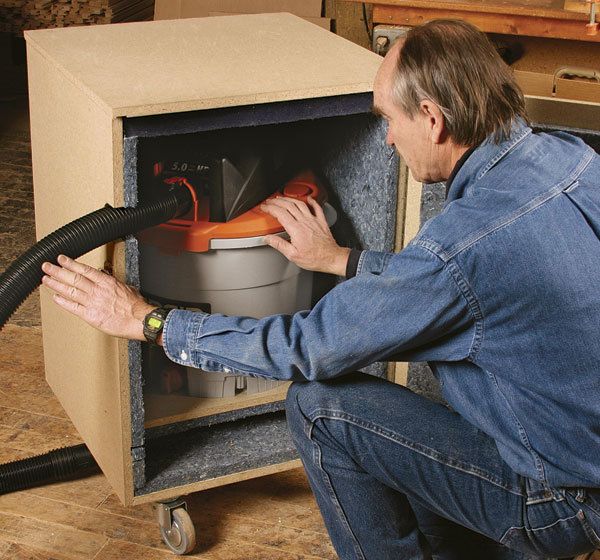Silence Your Shop Vac
Most vacuums are screaming banshees. A simple box stops the madness
Sanding used to give me the choice of two evils: I could use the sander’s onboard dust bag and let my lungs be the final filter, or I could attach a shop vacuum and replace dust pollution with noise pollution. To solve both problems, I built a particleboard box and lined it with acoustic padding. With the vacuum inside, the noise reduction was so great that I had it tested by a sound engineer. He registered an amazing 25-decibel reduction (see chart) to a level below that of an average conversation.
The vacuum can be switched on and off from outside the box, it will work with tool-activated vacuums, and I can now sand at will without creating either air or noise pollution.
Make the box in a morning
The concept and the design are simple. Acoustic panels absorb 50% or more of the sound that strikes them; the sound not absorbed is bounced into other parts of the box, gradually reducing the noise. The internal surfaces of the walls and top are lined with acoustic padding, and the exhaust from the vacuum passes through a baffle to extend its contact with the padding before exiting at the rear of the box.
Noise-containment box. The dimensions shown give an internal space of 20 in. deep by 20 in. wide by 24 in. tall. Click to enlarge.
The box shown here holds a 5-hp Ridgid vacuum, but the size can be adjusted to fit any machine. You’ll need the internal dimensions of the box to be at least 4 in. greater than the dimensions of the vacuum to allow space for the padding and for easy removal of the vacuum for emptying. For this size box, you’ll need a sheet and a half of 3/4-in.-thick particleboard or medium-density fiberboard (MDF). The greater density of MDF gives it slightly better sound-dampening properties, but it weighs and costs more.
Use a router to cut 1/8-in.-deep rabbets and dadoes to help align the sections. Use yellow glue and a 16-ga. nail gun to assemble the back, sides, and shelf. Then use construction adhesive to apply padding to the underside of the shelf and the thin strips at the bottom of the sides.

Apply the padding.
Apply the padding to the bottom before you attach it to the box. Apply padding to the rest of the inside, including the door. For extra noise suppression, use 2-in.-thick padding on the inside of the top, right above where the noisy exhaust exits the vacuum. Next, cut out the hole for the hose inlet.

Mark the hose inlet. Use the vacuum in the box to mark where the hose will enter the box.

Sacrificial board. For a cleaner cut through the padding, clamp a piece of plywood or Masonite to the inside.
Then attach the door hinge and latch, and screw on the casters. Feed the vacuum’s electrical cord through the exhaust outlet, but don’t plug it in. Turn on the vacuum’s switch, place the vacuum in the box, and close the door. Plug the vacuum into an extension cord with a switch. Throw the switch on the extension cord and enter a whole new world of peaceful vacuuming.
Measuring the Noise Reduction

A sound engineer measured the noise reduction after putting the vacuum in the noise-containment box. 83 decibels (db.) is on the threshold of needing hearing protection, while 58 db. is quieter than the average conversation.
Sources of Supply
Acoustic padding
Acoustical Surfaces Inc. (www.acousticalsurfaces.com; 800-527-6253) sells 2-ft. by 4-ft. batts of 1-in.-thick acoustic padding with a noise-reduction coefficient (NRC) of 0.80 for $18, and 2-in.-thick pads (NRC 1.15) for $32.
Ceiling tiles
You also can use ceiling tile from home centers. Many have labels giving the NRC. Look for an NRC of at least 0.50, which absorbs 50% of the sound.
From Fine Woodworking #195
Photos: Mark Schofield; drawings: Vince Babak
Fine Woodworking Recommended Products

Double Sided Tape

Veritas Precision Square

Starrett 12-in. combination square
























Comments
Can you add a PDF link?
What about exhaust, where does it exhaust to?
And yes, a PDF link would be nice.
+1 for pdf link...
It is impossible to find the "acoustic padding" at the Acoustic Surfaces website. All the product headings are either proprietary names like "Poly Max" or extremely specific applications, like "Decorative Fabric Wrapped Panels." That gives is zero guidance.
What is the specific name of the product? Or, just give us a direct link to the product?
Log in or create an account to post a comment.
Sign up Log in